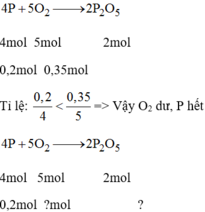Hãy nhập câu hỏi của bạn vào đây, nếu là tài khoản VIP, bạn sẽ được ưu tiên trả lời.

ta có : nP=9,3:31=0,3 mol
nO=5,6:22,4=0,25 mol
PTHH: 5O2 + 2P\(\rightarrow\) 2P2O5
ban đầu: 0,25 0,3 (mol)
phản ứng: 0,25 \(\rightarrow\) 0,25 (mol)
sau phản ứng: 0 0,05 0,1 (mol)
vậy sau phản ứng O2 hết còn P dư
mP dư= 0,05.31=1,55 g
b) chất P2O5
mP2O5= 0,1.390=39 g

Bài 2: (chị Hương Giang làm cho bạn bài 1 rồi)
Áp dụng ĐLBTKL, ta có:
mM + mO2 = mM2On
=> mO2 = 4 - 2,4 = 1,6 (g)
nO2 = 1,6/32 = 0,05 (mol)
PTHH: 4M + nO2 -> (to) 2M2On
Mol: 0,2/n <--- 0,05
M(M) = 2,4/(0,2/n) = 12n (g/mol)
Xét:
n = 1 => Loại
n = 2 => M = 24 => Mg
n = 3 => Loại
Vạya M là Mg

a)
Số mol photpho : 0,4 (mol).
Số mol oxi : 0,53 (mol).
Phương trình phản ứng :
4P + 5O2 -> 2P2O5
0,4 0,5 0,2 (mol)
Vậy số mol oxi còn thừa lại là :
0,53 – 0,5 = 0,03 (mol).
b) Chất được tạo thành là P2O5 . Theo phương trình phản ứng, ta có :
0,2 (mol).
Khối lượng điphotpho pentaoxit tạo thành là : m = 0,2.(31.2 + 16.5) = 28,4 gam.
a) PTHH: 4P + 5O2 -to-> 2P2O5
Ta có: \(n_P=\dfrac{12,4}{31}=0,4\left(mol\right)\\ n_{O_2}=\dfrac{17}{32}\left(mol\right)\)
Theo PTHH và đề bài, ta có:
\(\dfrac{0,4}{4}< \dfrac{\dfrac{17}{32}}{5}\)
=> P hết, O2 dư nên tính theo nP.
=> \(n_{O_2\left(phảnứng\right)}=\dfrac{5.0,4}{4}=0,5\left(mol\right)\\ =>n_{O_2\left(dư\right)}=\dfrac{17}{32}-0,5=\dfrac{1}{32}\left(mol\right)\)
b) Chất tạo thành sau phản ứng là P2O5 (điphotpho pentaoxit).
Theo PTHH và đề bài, ta có:
\(n_{P_2O_5}=\dfrac{2.0,4}{4}=0,2\left(mol\right)\)
Khối lượng P2O5 tạo thành sau phản ứng:
\(m_{P_2O_5}=0,2.142=28,4\left(g\right)\)

\(n_P=\dfrac{m_P}{M_P}=\dfrac{12,4}{31}=0,4mol\)
\(n_{O_2}=\dfrac{m_{O_2}}{M_{O_2}}=\dfrac{17}{32}=0,53125mol\)
\(4P+5O_2\rightarrow\left(t^o\right)2P_2O_5\)
0,4 < 0,53125 ( mol )
0,4 0,5 0,2 ( mol )
\(n_{O_2\left(du\right)}=0,53125-0,5=0,03125mol\)
Chất được tạo thành là P2O5
\(m_{P_2O_5}=n_{P_2O_5}.M_{P_2O_5}=0,2.142=18,4g\)

nP = 6.2/31 = 0.2 (mol)
nO2 = 6.72/22.4 = 0.3 (mol)
4P + 5O2 -to-> 2P2O5
0.2___0.25_____0.1
mO2 dư = ( 0.3 - 0.25) * 32 = 1.6(g)
mP2O5 = 0.1*142 = 14.2 (g)
Ta có: \(n_P=\dfrac{6.2}{31}=0.29mol\)
\(n_{O_2}=\dfrac{6.72}{22.4}=0.3mol\)
PTHH:
\(4P+5O_2\underrightarrow{t^o}2P_2O_5\)
ta có:
\(\left\{{}\begin{matrix}\dfrac{n_{P\left(bra\right)}}{nP_{\left(pthh\right)}}=\dfrac{0.2}{4}=0.05\\\dfrac{n_{O_2\left(bra\right)}}{n_{O_2}\left(pthh\right)}=\dfrac{0.3}{5}=0.06\end{matrix}\right.\)
=> \(O_2\) dư
\(4P+5O_2\underrightarrow{t^o}2P_2O_5\)
4 ----------->2
0.2---------->0.1=nP2O5
=>\(m_{P_2O_5}=142.0.1=14.2\left(g\right)\)

nP=\(\dfrac{62}{31}\)=0,2(mol)
nO2=\(\dfrac{7,84}{22,4}\)=0,35(mol)
PTHH:4P+5O2to→2P2O5
tpứ: 0,2 0,35
pứ: 0,2 0,25 0,1
spứ: 0 0,1 0,1
a)chất còn dư là oxi
mO2dư=0,1.32=3,2(g)
b)mP2O5=n.M=0,1.142=14,2(g)
\(a.n_P=0,2\left(mol\right);n_{O_2}=0,35\left(mol\right)\\ 4P+5O_2-^{t^o}\rightarrow2P_2O_5\\ LTL:\dfrac{0,2}{4}< \dfrac{0,35}{5}\\ \Rightarrow SauphảnứngO_2dư\\ n_{O_2\left(pứ\right)}=\dfrac{5}{4}n_P=0,25\left(mol\right)\\ \Rightarrow m_{P\left(dư\right)}=\left(0,35-0,25\right).32=3,2\left(g\right)\\ b.n_{P_2O_5}=\dfrac{1}{2}n_P=0,1\left(mol\right)\\ \Rightarrow m_{P_2O_5}=0,1.142=14,2\left(g\right)\)






a) PTPU: \(4P+5O_2\rightarrow2P_2O_5\)
\(nP=\frac{6,2}{31}=0,2mol\)
\(n_{O_2}=\frac{7,84}{22,4}=0,35mol\)
\(n_{O_2}\) (Tính theo P) \(=\frac{0,2.5}{4}=0,25mol\)
\(\rightarrow O_2\) dư
\(\rightarrow n_{O_2\text{(dư)}}=0,35-0,35=0,1mol\)
\(\rightarrow m_{O_2\text{(dư)}}=0,1.32=3,2g\)
b) \(m_{O_2\text{(phản ứng)}}=0,25.32=8g\)
Theo ĐLBTKL: \(mP+m_{O_2}=m_{P_2O_5}\rightarrow m_{P_2O_5}=6,2+8=14,2g\)